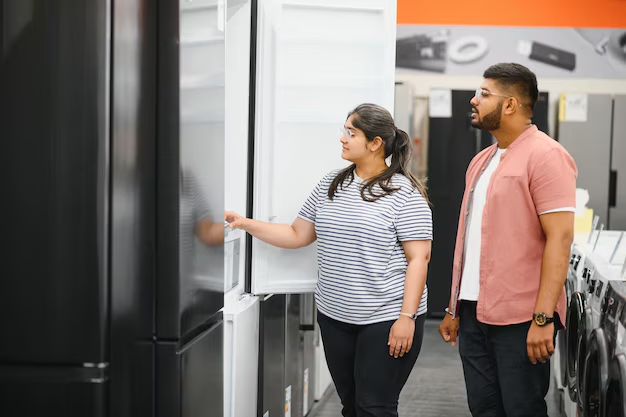Understanding Refrigerator Cubic Feet: What You Need to Know
Are you puzzled by what "cubic feet" means when shopping for a refrigerator? This term often pops up on product descriptions, yet not everyone fully grasps its significance or how it impacts their buying decision. Let's dive deep into the world of refrigerators, unraveling the mystery of cubic feet and how this measurement can guide you to the perfect fridge for your needs.
What Are Cubic Feet, and Why Do They Matter?
Cubic feet (cu. ft.) is a standard unit of measurement for volume, particularly in appliances like refrigerators. This measurement denotes how much space is available within the fridge. The volume expressed in cubic feet tells you how much food and drink your refrigerator can accommodate.
Key Reasons Cubic Feet Matter
- Space Optimization: Understanding the volume helps you choose a refrigerator that fits both your kitchen space and your storage needs.
- Efficiency: Larger volume often means more energy consumption. Knowing the cubic footage can help evaluate potential energy use.
- Cost: Larger refrigerators typically come with higher price tags, not just in terms of purchase but also operational costs.
Measuring Refrigerator Capacity in Cubic Feet
When manufacturers state the capacity of a refrigerator, they usually refer to the total interior volume of both the fridge and freezer sections combined. Here's how you can easily visualize and understand this measurement:
- Width x Height x Depth: Cubic feet are calculated by multiplying the interior width, height, and depth of the compartments.
- Volume Breakdown: Often, refrigerators come with separate figures for the fridge and freezer compartments, helping buyers understand the layout more precisely.
Example of Calculating Cubic Feet
To comprehend how this calculation works, imagine a refrigerator section that measures 3 feet wide, 5 feet high, and 2 feet deep. The volume is:
Pro Tip: Roomy But Not Bulky!
While a larger cubic footage might seem appealing, also consider potential difficulties in fitting it through doorways or aligning it with your kitchen counters. Measure your kitchen space meticulously to make sure the chosen refrigerator won't be a misfit.
Choosing the Right Refrigerator Size
Once you're aware of what cubic feet imply, another big question emerges: what size should you choose? This primarily depends on household size and lifestyle.
Household Size and Refrigerator Volume
- One or Two People: A refrigerator with 10-20 cu. ft. should suffice.
- Typical Family of Four: Opt for 20-30 cu. ft. for adequate storage.
- Larger Households: Consider a unit 30 cu. ft. or more.
Lifestyle Considerations
- Frequent Entertainer: If you host gatherings often, a larger fridge can accommodate party platters and bulkier items.
- Batch Cooker: Those who prepare meals in advance may require extra freezer space.
Types of Refrigerators by Cubic Feet
The format of your refrigerator may affect its cubic footage and functionality. Here’s a breakdown of popular styles:
Top-Freezer Models
- Pros: Generally more affordable and efficient.
- Cons: Freezer compartments tend to be smaller.
- Typical Size: 14-20 cu. ft., with a balanced space for fridge and freezer needs.
Bottom-Freezer Designs
- Pros: Easier access to fridge section.
- Cons: May occupy more floor space due to larger door swings.
- Typical Size: 18-25 cu. ft., maximizing refrigerator accessibility.
Side-by-Side Options
- Pros: Equal access to both fridge and freezer.
- Cons: Generally narrower compartments.
- Typical Size: 20-30 cu. ft., ideal for organizing stored goods efficiently.
French Door Models
- Pros: Spacious and modern, great for wide items and platters.
- Cons: Often pricier and less energy-efficient.
- Typical Size: 22-35 cu. ft., provides flexible storage solutions.
Compact Refrigerators
- Pros: Great for tight spaces like dorms or offices.
- Cons: Limited capacity.
- Typical Size: 3-6 cu. ft., a perfect fit for minimal refrigeration needs.
Energy Efficiency Considerations
One crucial aspect intertwined with refrigerator volume is its energy efficiency. Larger units often consume more energy, but higher efficiency models can mitigate extra costs. Here’s how to align your size choice with eco-friendly options:
Energy Star Ratings
Always look for Energy Star-rated refrigerators. These models meet or exceed energy-efficiency guidelines set by authorities, offering savings on energy bills without sacrificing performance or capacity.
Tips for Efficient Use
- Regular Maintenance: Clean coils and check seals to ensure optimal performance.
- Smart Organization: Arrange contents to allow air circulation, reducing the compressor's workload.
- Proper Filling: Running your fridge at around 70% full maximizes cooling potential without overburdening the system.
Visually Comparing Fridge Sizes and Efficiency
To summarize various refrigerator styles and the typical range of cubic feet:
| Style | Typical Cubic Feet | Best For |
|---|---|---|
| Top-Freezer | 14-20 | Budget-conscious buyers |
| Bottom-Freezer | 18-25 | Those who prefer easy access |
| Side-by-Side | 20-30 | Organizers |
| French Door | 22-35 | Large families, entertainers |
| Compact | 3-6 | Small spaces, minimal needs |
✨ Choosing Tips:
- 🛠️ Measure your kitchen space carefully.
- 🌿 Consider an Energy Star model for sustainability.
- 📦 Confirm that the cubic feet align with your storage requirements.
Choosing a refrigerator involves more than just picking a stylish model. Understanding cubic feet helps balance your storage needs with space constraints and energy consumption.
Unlocking the cubic footage mystery not only enlightens your appliance shopping experience but also empowers you to make a well-rounded choice, incorporating practical and sustainable elements.
Armed with this knowledge, may your next refrigerator selection truly chill without breaking the bank! 😊
